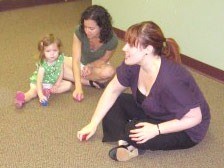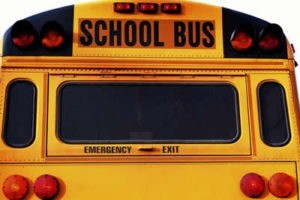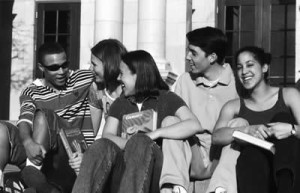By: Holly Rand, MT-BC
 Being a music therapist is a really exciting and dynamic job. At any given moment my car has some sort of collection of instruments in it, which leads all of the passengers in my car to ask, “what is that noise?”. Typically it is a bag of tambourines, maracas, bells, frame drums, rain sticks…you name it, it’s probably in my bag of tricks. And that bag of tricks and I travel all over to make music with some really outstanding individuals.
Being a music therapist is a really exciting and dynamic job. At any given moment my car has some sort of collection of instruments in it, which leads all of the passengers in my car to ask, “what is that noise?”. Typically it is a bag of tambourines, maracas, bells, frame drums, rain sticks…you name it, it’s probably in my bag of tricks. And that bag of tricks and I travel all over to make music with some really outstanding individuals.
Here’s a look at a typical day in my job. It will give you an idea of
– the work my clients and I do
– the music we create and
– the successes that grow out of the therapeutic uses of music.
First, It’s Off to School
Charlestown High School
 I start my day at 8:30 AM at Charlestown High School. Here, I work with a group of teenagers with various disabilities. We focus a lot on social interaction and movement in this group. So, for example, I’ll set up an instrument improvisation where everyone chooses and instrument and then we all jam until I give the cue to trade instruments. The kids then get up and ask their peers if they can have their instrument. The physical aspect of this is significant for most of these kids, as many of them have physical challenges, and the chance for appropriate social interaction is incredibly important. It really gives them an opportunity to have a successful social exchange and it is a wonderful model for them to carry over outside of the session.
I start my day at 8:30 AM at Charlestown High School. Here, I work with a group of teenagers with various disabilities. We focus a lot on social interaction and movement in this group. So, for example, I’ll set up an instrument improvisation where everyone chooses and instrument and then we all jam until I give the cue to trade instruments. The kids then get up and ask their peers if they can have their instrument. The physical aspect of this is significant for most of these kids, as many of them have physical challenges, and the chance for appropriate social interaction is incredibly important. It really gives them an opportunity to have a successful social exchange and it is a wonderful model for them to carry over outside of the session.
Professional Center for Child Development – Developmental Day School
Next, I head up to Andover to run a group for young children with multiple disabilities at the Professional Center for Child Development. These little guys are great. Getting these kids to vocalize or say hello on a pre-recorded switch is something that we work hard on. I try to bring out the little soul singers in them by starting the group with a blues hello song. Some of the kids use their voices and some use the switch, and all of them do a great job of greeting their friends. We also work a lot on choice-making in this group, which can be choosing an instrument to play from 2 or 3 depending on individual abilities and goals, or choosing an animal to sing about during the famous farm song. The kids are really motivated to make a choice because, really, who wouldn’t want to choose an instrument or an animal to sing about? But even when it seems like just fun, I am consciously and intentionally addressing their goals and objectives.
EMBARK – A Program of Northshore Education Consortium
 Now, I’m on to the EMBARK program, which is a school-based program for youth ages 18-22 with various disabilities, located in Salem. We have been working on songwriting in this group, and our most recent project is a rap about Redbull. It’s pretty amazing.
Now, I’m on to the EMBARK program, which is a school-based program for youth ages 18-22 with various disabilities, located in Salem. We have been working on songwriting in this group, and our most recent project is a rap about Redbull. It’s pretty amazing.
The kids control the entire songwriting process, from writing the lyrics, to choosing what style of music the lyrics will be set to. This is a great way for these kids to work on social skills by structuring and supporting appropriate social interactions with their peers. We have finished the rap, and are now in the process of recording it, and when that is complete we will put it together with the other songs the group has recorded to create a CD. We are all really psyched about the CD release party to unveil the final product. This is a really talented bunch of kids, and it is wonderful to see them interact with each other to create some really great music.
Individual Music Therapy in the School Setting
My next stop is an individual session with a high school student. Because we are working on choice-making and successful independence, the client chooses what we do and the session is always changing and evolving. We write songs, we listen to pre-recorded music and discuss the lyrics and we play instruments.
There is never a dull moment and he keeps me on my toes with all of his classical music knowledge. In a recent session, I brought in Vivaldi’s “Spring” and within the first 3 seconds of play, he knew the title and composer. He has really made significant progress in his work in music therapy and he is now able to take turns leading and following in the music during our sessions.
Early Intervention
My last session is with a child receiving early intervention services. I love working with this little guy. It is clear in each of our sessions how happy he is to be in music. My favorite thing in this session is typically the hello song. We start off with a very structured song, and by the end of it we are just improvising together.
Vocalization is one of the goals for him, and by improvising, I allow him space to vocalize any way that he chooses, and then I respond by mirroring back what he sang. Also, by stopping the guitar and waiting for him to vocalize, we are addressing the goal of understanding cause and effect, which is an important goal for him. He really appears to love to sing, and given enough time and space, he can get his little vocal engine warmed up and create some really great music.
Paperwork and Documentation
 So, there you have it. That is what a typical day looks like for me.
So, there you have it. That is what a typical day looks like for me.
Actually, I forgot the part about how after all of that, you can usually find me drinking a chai latte and doing my documentation for all of my sessions at Jam ‘n Java in Arlington. It is such a great way to finish my day. I am very grateful to be able to have a job doing something that I love. It is so rewarding to be a part of my clients’ processes and help them to reach their goals through our music together.
To Contact Holly Rand, MT-BC, call 781-665-0700 or email info@romanmusictherapy.com.
